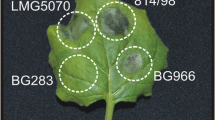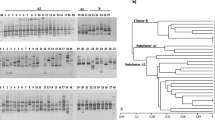Abstract
ITS sequences determined for 53 Erysiphe specimens on Syringa and Ligustrum collected in Europe, East Asia, and North and South America were divided into two ITS groups, S and K types. Phylogenetic analysis showed that these two ITS types do not share a common ancestor and form separate clades. The K type on Ligustrum was identified as Erysiphe ligustri based on the three-dimensional branching pattern of appendages. Morphological observations showed that there are some morphological differences—pigmentation of appendages and number of ascospores per ascus—between the S and K types on Syringa. Based on these morphological observations, the S and K types on Syringa were identified as E. syringae and E. syringae-japonicae, respectively. The recent abundant production of chasmothecia by lilac powdery mildew in Europe was caused by E. syringae-japonicae introduced from East Asia. DNA sequence analyses of the rDNA ITS region and the 28S rDNA, tub2, CYP51, and Chs1 genes did not support an interspecific hybrid origin for E. syringae-japonicae. Haplotype analysis suggested that E. syringae originated in North America and independently migrated to East Asia and Europe/South America.





Similar content being viewed by others
References
Blumer S (1951) Das epidemische Auftreten eines Oidiums auf Syringa vulgaris L. Phytopathol Z 18:478–488
Bolay A (2005) Les Oïdiums de Suisse (Erysiphaceae). Cryptogam Helv 20:1–173
Braun U (1982) Descriptions of new species and combinations in Microsphaera and Erysiphe. Mycotaxon 15:121–137
Braun U (1987) A monograph of the Erysiphales (powdery mildews). Beih Nova Hedwigia 89:1–700
Braun U (1998) Neufunde Echter Mehltaupilze (Erysiphales) aus der B.R. Deutschland. Schlechtendalia 1:31–40
Felsenstein J (1985) Confidence limits on phylogenies: an approach using the bootstrap. Evolution 39:783–791
Hirata T, Takamatsu S (1996) Nucleotide sequence diversity of rDNA internal transcribed spacers extracted from conidia and cleistothecia of several powdery mildew fungi. Mycoscience 37:265–270
Huelsenbeck JP, Ronquist F (2001) MrBayes: Bayesian inference of phylogenetic trees. Bioinformatics 17:754–755
Kunoh H, Ishizaki H, Nakaya K (1977) Cytological studies of early stages of powdery mildew in barley and wheat leaves: (II) significance of the primary germ tube of Erysiphe graminis on barley leaves. Physiol Plant Pathol 10:191–199
Kusaba M, Tsuge T (1995) Phylogeny of Alternaria fungi known to produce host-specific toxins on the basis of variation in internal transcribed spacers of ribosomal DNA. Curr Genet 28:491–498
Li J, Alexander JH, Zhang D (2002) Paraphyletic Syringa (Oleaceae): evidence from sequences of nuclear ribosomal DNA ITS and ETS regions. Syst Bot 27:592–597
Mori Y, Sato Y, Takamatsu S (2000) Evolutionary analysis of the powdery mildew fungi using nucleotide sequences of the nuclear ribosomal DNA. Mycologia 92:74–93
Nixon KC (1999) The parsimony ratchet, a new method for rapid parsimony analysis. Cladistics 15:407–414
Nylander JAA (2004) MrModeltest v2 (program distributed by the author). Evolutionary Biology Centre, Uppsala University, Uppsala
Seko Y, Bolay A, Kiss L, Heluta V, Grigaliunaite B, Takamatsu S (2008) Molecular evidence in support of recent migration of a powdery mildew fungus on Syringa spp. into Europe from East Asia. Plant Pathol 57:243–250
Shin HD (2000) Erysiphaceae of Korea. Plant pathogens of Korea 1. National Institute of Agricultural Science and Technology, Suwon
Sikes DS, Lewis PO (2001) PAUPRat: PAUP* implementation of the parsimony ratchet, beta software, version 1 (distributed by the authors). Department of Ecology and Evolutionary Biology, University of Connecticut, Storrs
Swofford DL (2001) PAUP: phylogenetic analysis using parsimony (and other methods) 4.0b8. Sinauer, Sunderland
Takamatsu S, Kano Y (2001) PCR primers useful for nucleotide sequencing of rDNA of the powdery mildew fungi. Mycoscience 42:135–139
Takamatsu S, Hirata T, Sato Y, Nomura Y (1999) Phylogenetic relationships of Microsphaera and Erysiphe section Erysiphe (powdery mildews) inferred from the rDNA ITS sequences. Mycoscience 40:259–268
Thompson JD, Gibson TJ, Plewniak F, Jeanmougin F, Higgins DG (1997) The ClustalX windows interface: flexible strategies for multiple sequence alignment aided by quality analysis tools. Nucleic Acids Res 24:4876–4882
Walsh PS, Metzger DA, Higuchi R (1991) Chelex 100 as a medium for simple extraction of DNA for PCR-based typing from forensic material. BioTechniques 10:506–513
White TJ, Bruns TD, Lee S, Taylor J (1990) Amplification and direct sequencing of fungal ribosomal genes for phylogenetics. In: Innis MA, Gelfand DH, Sninsky JJ, White TJ (eds) PCR protocols. Academic, San Diego, pp 315–322
Acknowledgments
Sincere thanks are due to Drs A. Bolay (Geneva, Switzerland), M. Havrylenko (Bariloche, Argentina), L. Kiss (Budapest, Hungary), Y. Nomura (Chiba, Japan), Y. Sato (Toyama, Japan), A. Schmidt (Lübeck, Germany), S. Tanda (Tokyo, Japan) for kindly providing specimens, and also to anonymous reviewers for suggestions and editorial comments. This work was supported in part by the Institution for Fermentation, Osaka (IFO).
Author information
Authors and Affiliations
Corresponding author
About this article
Cite this article
Seko, Y., Heluta, V., Grigaliunaite, B. et al. Morphological and molecular characterization of two ITS groups of Erysiphe (Erysiphales) occurring on Syringa and Ligustrum (Oleaceae). Mycoscience 52, 174–182 (2011). https://doi.org/10.1007/s10267-010-0088-x
Received:
Accepted:
Published:
Issue Date:
DOI: https://doi.org/10.1007/s10267-010-0088-x




